ノーコードでエアコンの電力消費を可視化する手順(Telegraf + Promethes + Grafana Mimir + Grafana)ではRaspberry Pi環境内ですべて完結していましたが、Grafana Minirの代わりにAmazon Managed Service for Prometheus (AMP)を使うことも可能です。
「grafana」タグの記事が6件件あります
全てのタグを見るノーコードでエアコンの電力消費を可視化する手順(Telegraf + Promethes + Grafana Mimir + Grafana)
今年の夏も暑かったですね。エアコンがないとやってられませんでした。 ふと、エアコンの電力消費が気になりましたので可視化してみました。
Amazon Managed Service for PrometheusとAmazon Managed Grafana使ってみた
過去にQiitaに投稿した内容のアーカイブです。
Amazon Managed Service for PrometheusとAmazon Managed Grafanaを使ってRaspberry Piのメトリクスを可視化してみました。(名前が長い。。そして統一感がない。。)
Amazon Managed Service for Prometheusのセットアップ

ワークスペースの名称を決めるだけです。
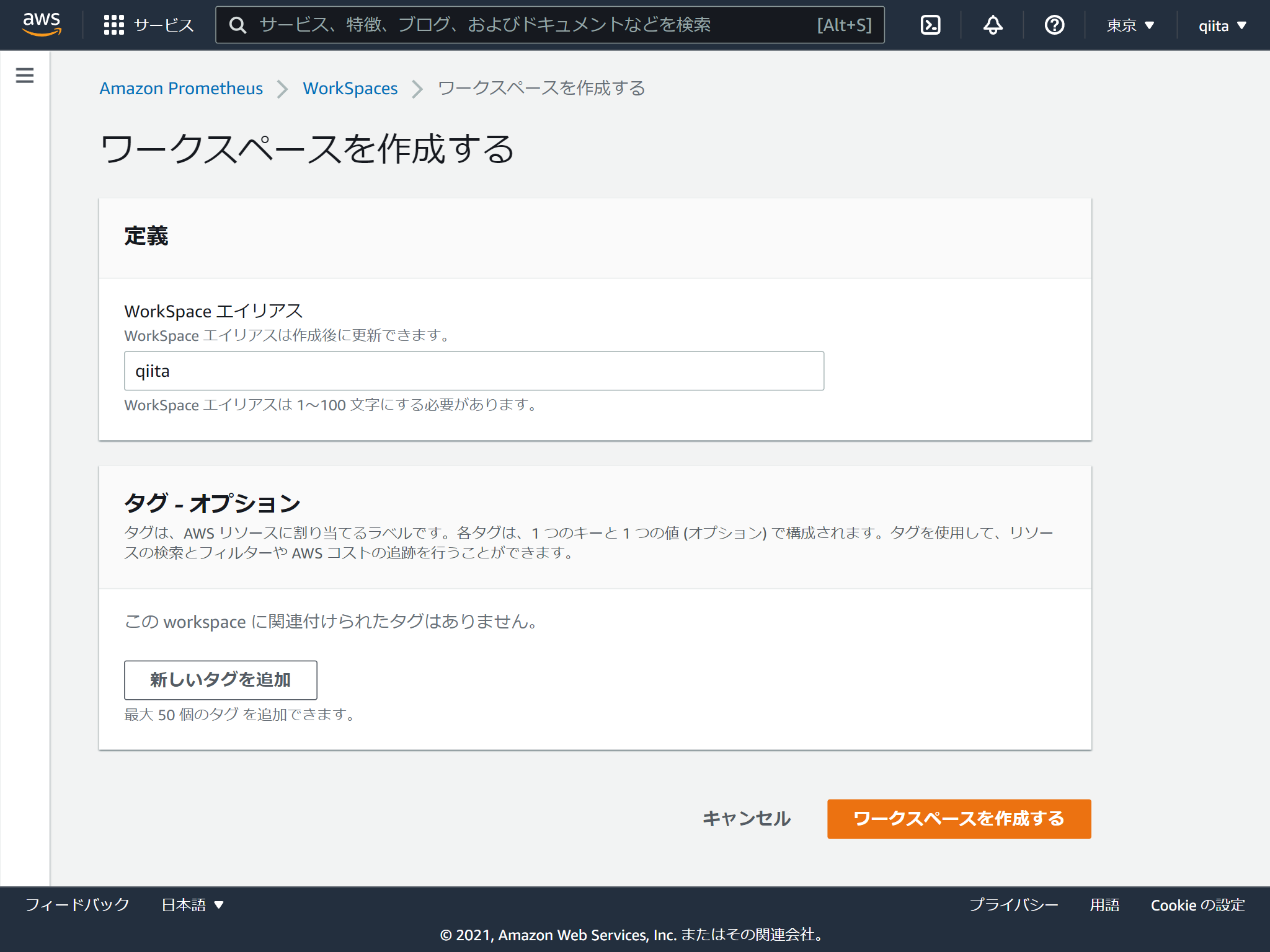
出来上がり。超簡単
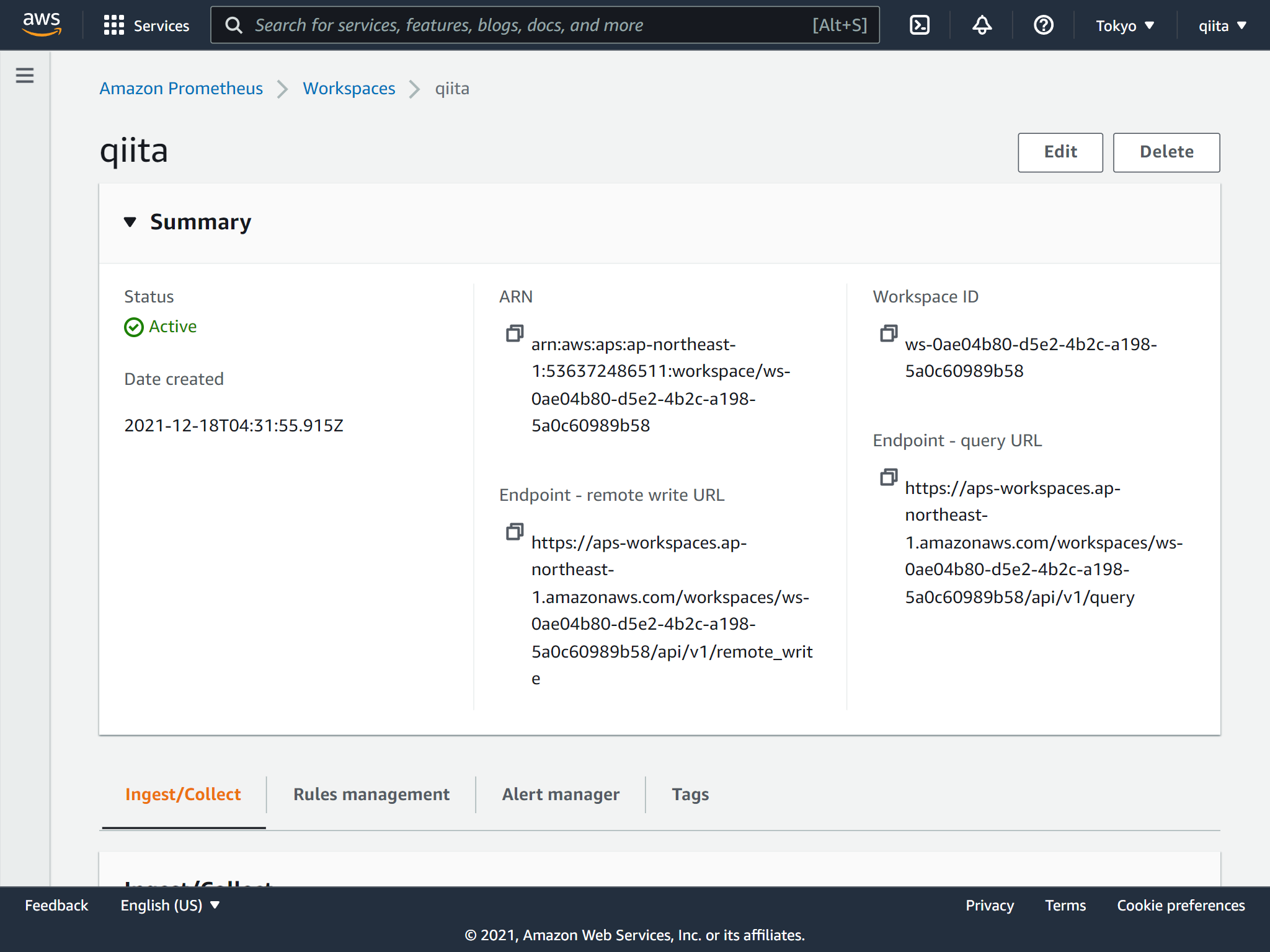
Raspberry Pi4からメトリクスを送信
IAMユーザーのアクセスキー情報が必要ですので、IAMユーザーを作成します。
必要なポリシーはこんな感じです。aps:RemoteWriteだけでいいかもしれません。
注意点はなんといってもサービス名が AMP ってところです。さらにActionの接頭辞は aps (笑)
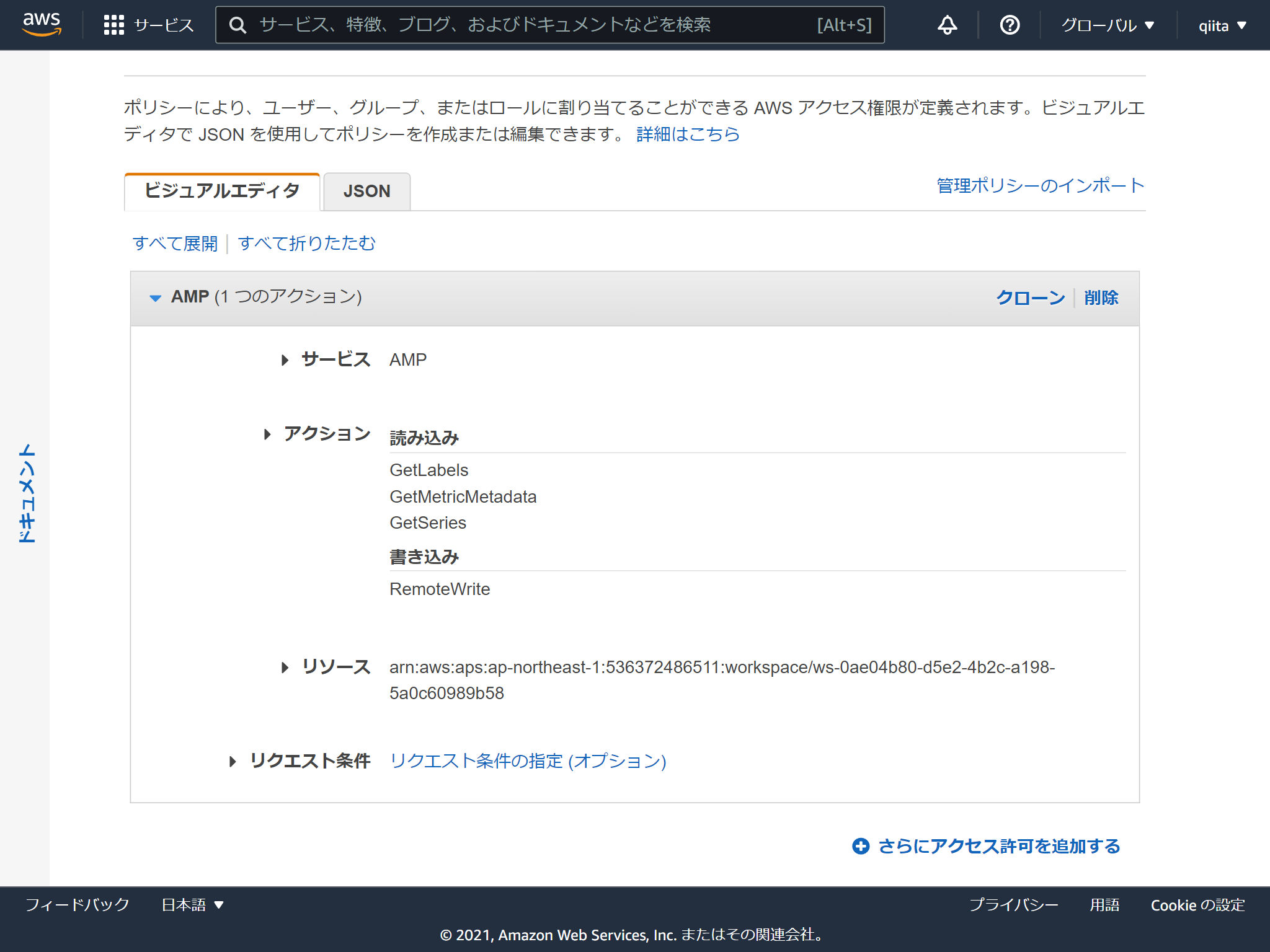
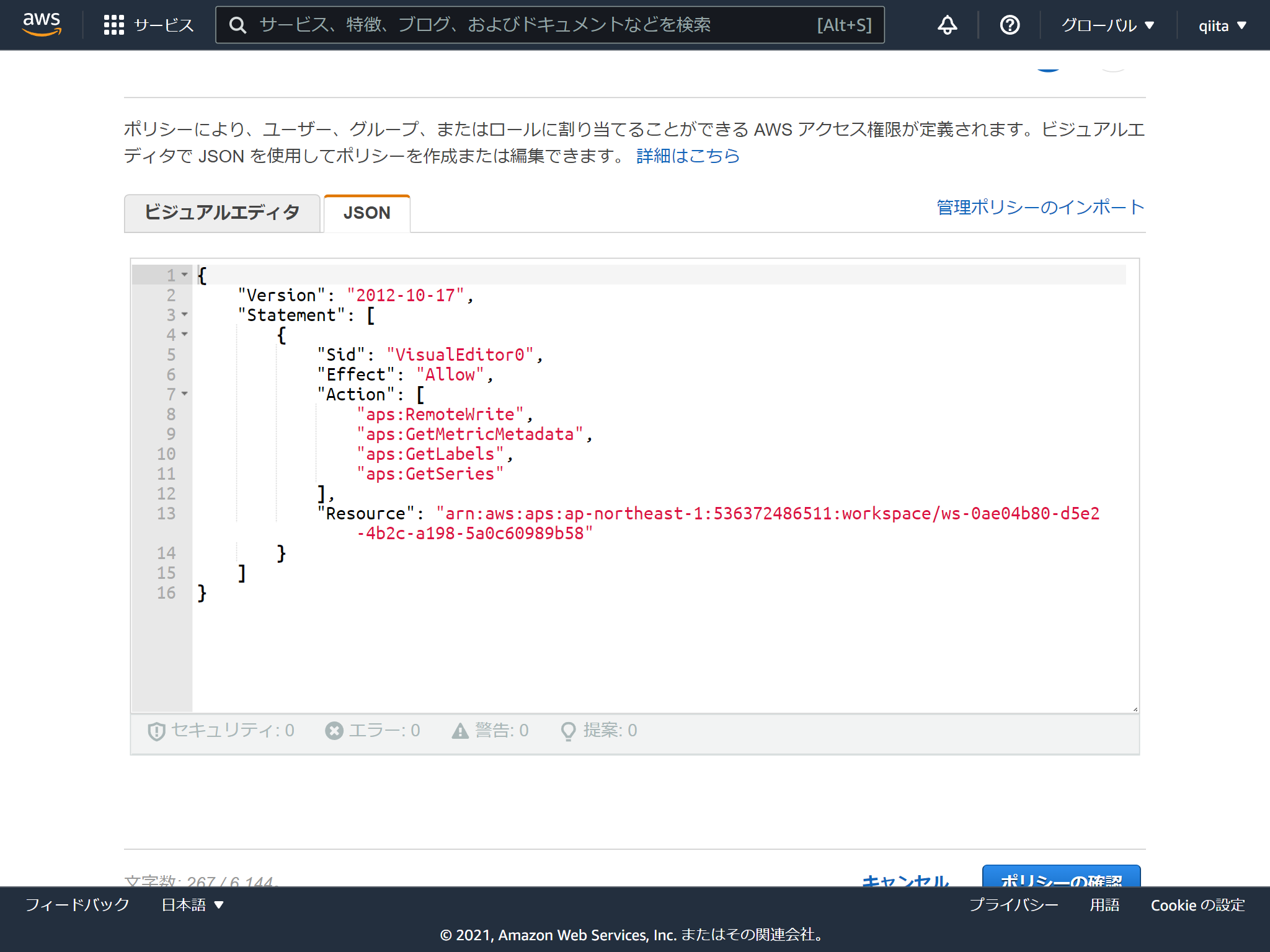
Docker ComposeでPrometheusとNode exporterを起動します。
version: '3.8'
services:
prometheus:
image: quay.io/prometheus/prometheus:latest
network_mode: host
volumes:
- ./prometheus.yml:/etc/prometheus/prometheus.yml
node-exporter:
image: quay.io/prometheus/node-exporter:latest
container_name: node_exporter
command:
- '--path.rootfs=/host'
network_mode: host
pid: host
restart: unless-stopped
volumes:
- '/:/host:ro,rslave'
remote_writeのところに認証情報をセットします。
## my global config
global:
scrape_interval: 15s # Set the scrape interval to every 15 seconds. Default is every 1 minute.
evaluation_interval: 15s # Evaluate rules every 15 seconds. The default is every 1 minute.
# scrape_timeout is set to the global default (10s).
## Alertmanager configuration
alerting:
alertmanagers:
- static_configs:
- targets:
# - alertmanager:9093
## Load rules once and periodically evaluate them according to the global 'evaluation_interval'.
rule_files:
# - "first_rules.yml"
# - "second_rules.yml"
## A scrape configuration containing exactly one endpoint to scrape:
## Here it's Prometheus itself.
scrape_configs:
# The job name is added as a label `job=<job_name>` to any timeseries scraped from this config.
- job_name: 'prometheus'
# metrics_path defaults to '/metrics'
# scheme defaults to 'http'.
static_configs:
- targets: ['localhost:9090']
- job_name: 'node'
static_configs:
- targets: ['localhost:9100']
remote_write:
- url: https://aps-workspaces.ap-northeast-1.amazonaws.com/workspaces/ws-0ae04b80-d5e2-4b2c-a198-5a0c60989b58/api/v1/remote_write
sigv4:
# The AWS region. If blank, the region from the default credentials chain
# is used.
region: ap-northeast-1
# The AWS API keys. If blank, the environment variables `AWS_ACCESS_KEY_ID`
# and `AWS_SECRET_ACCESS_KEY` are used.
access_key: XXXXXXXXXXXXXXXXXXXX
secret_key: XXXXXXXXXXXXXXXXXXXX
起動します
## docker-compose up
Amazon Managed Grafanaのセットアップ
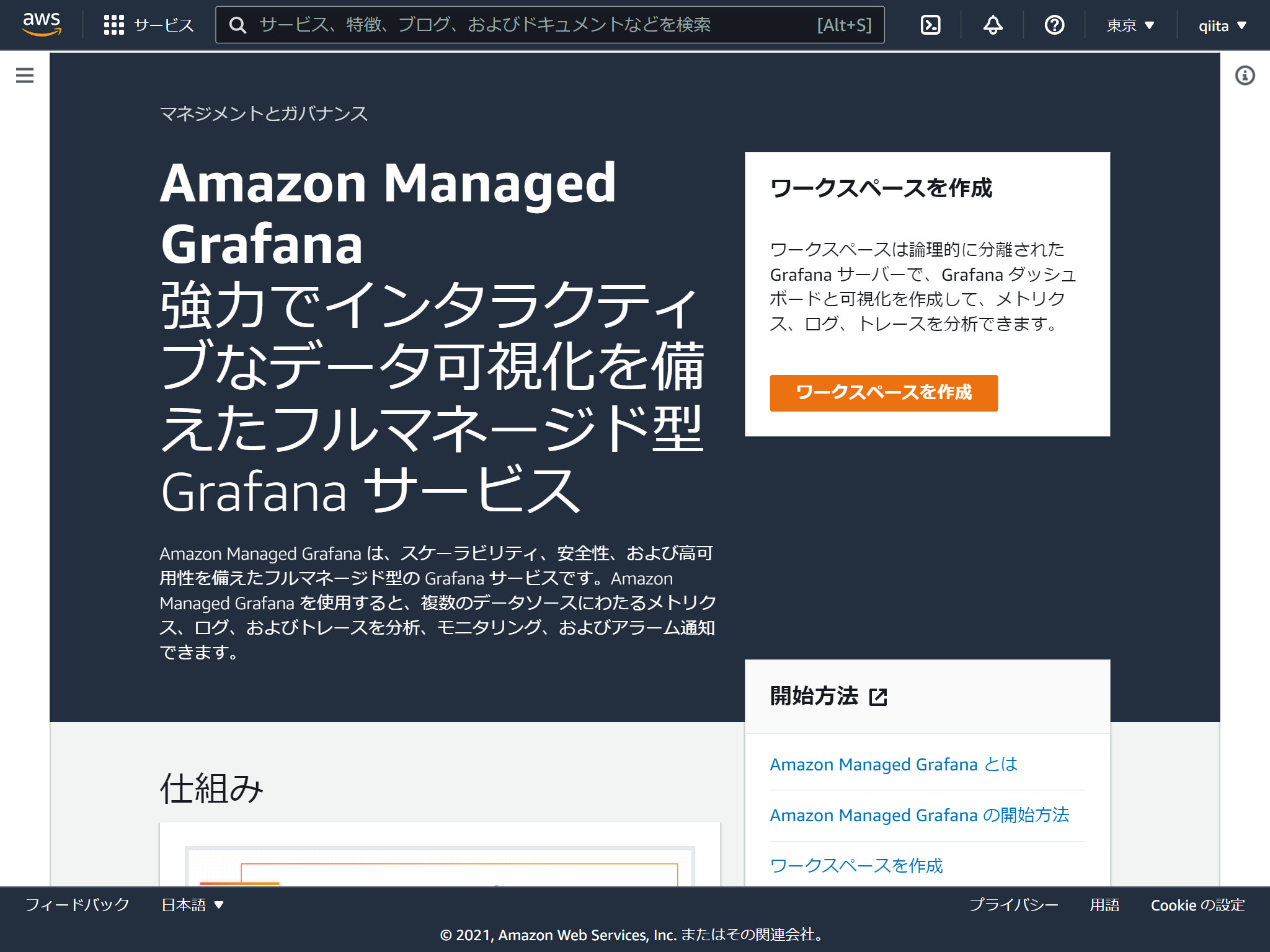
ワークスペース名をつけます
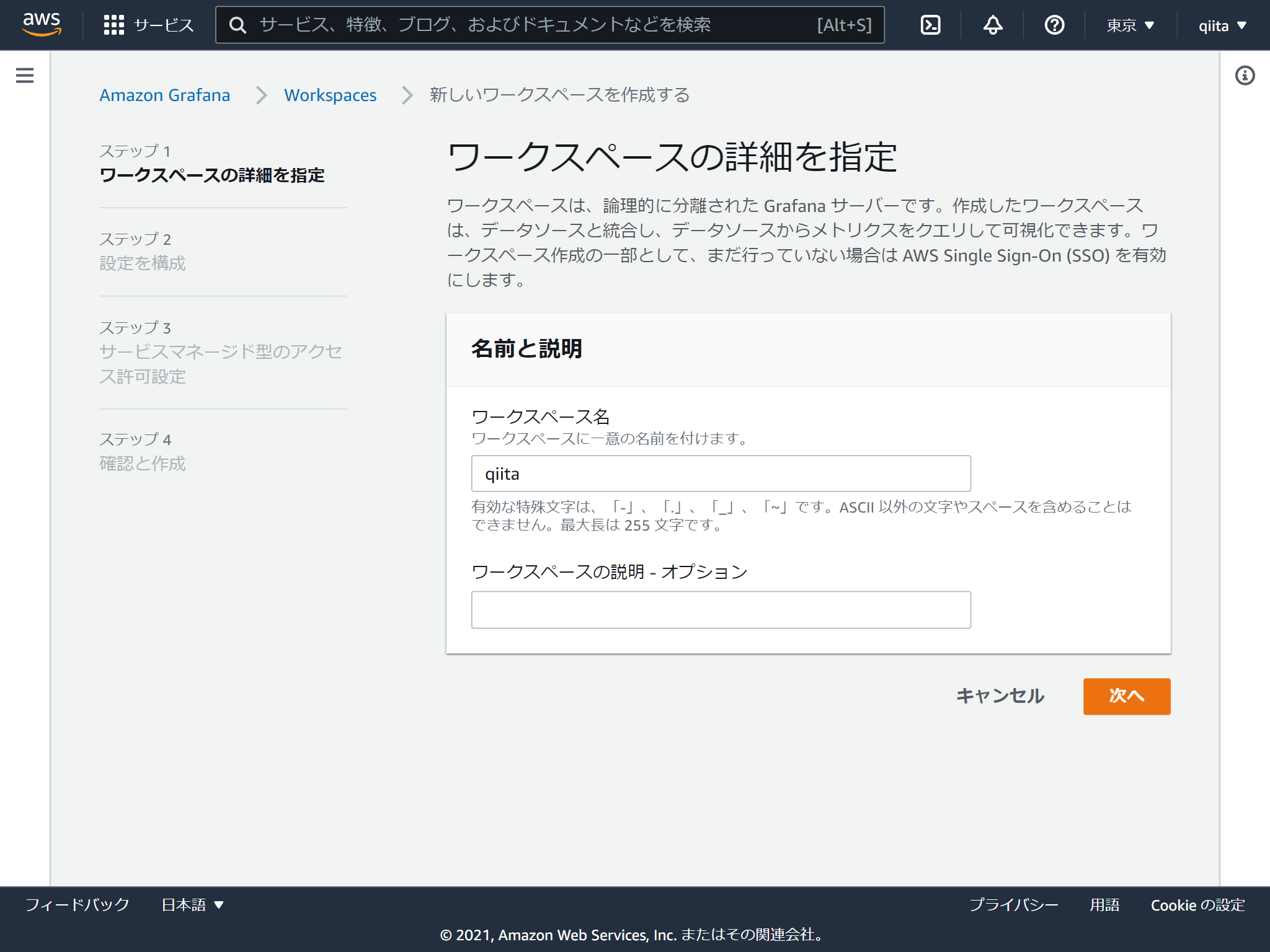
Grafanaの画面にログインする際に使う認証情報を選択します。AWS SSOにしてみました。
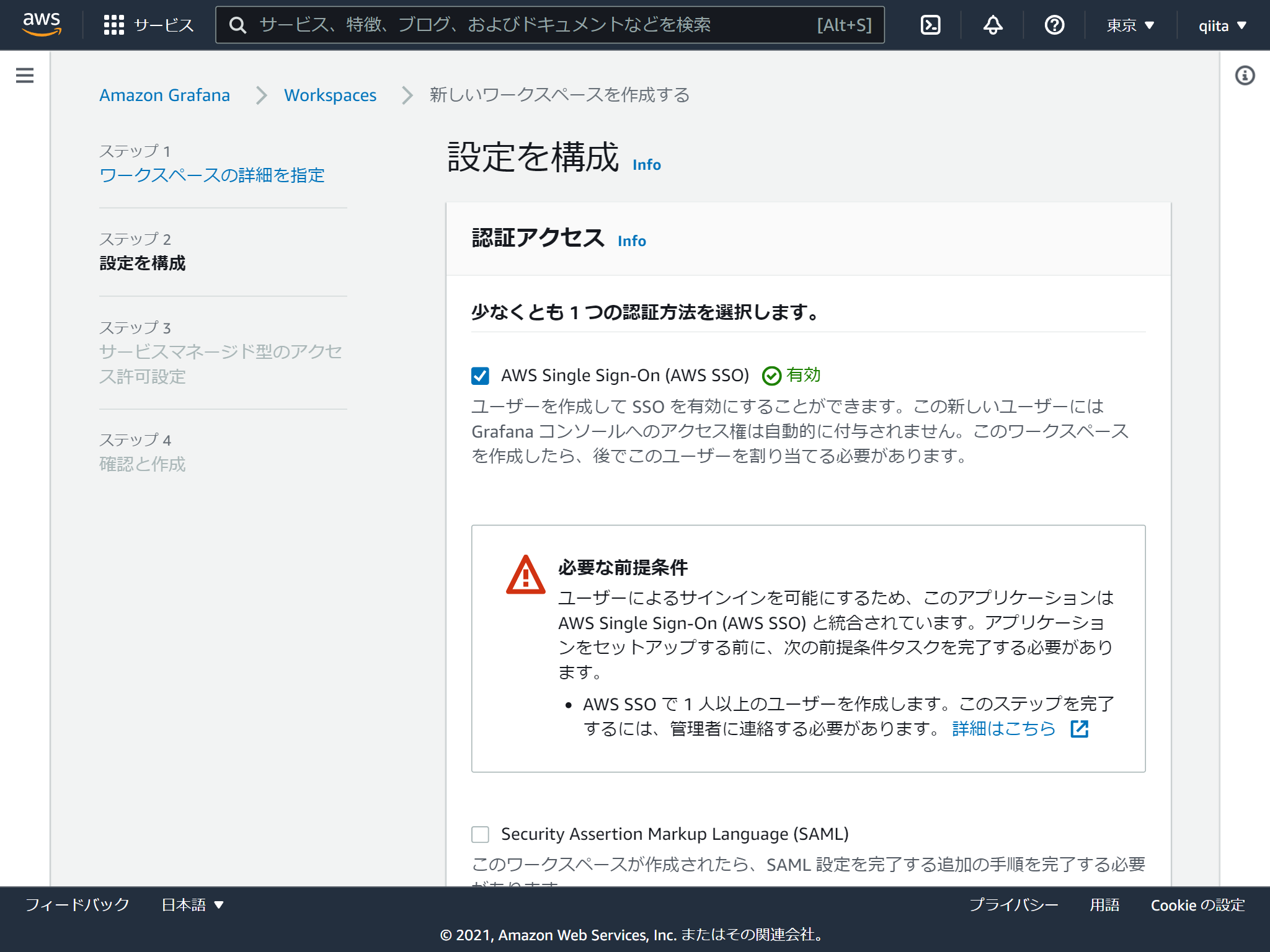
GrafanaがアクセスするAWSのリソースを選択します。 あとからも変更できます。
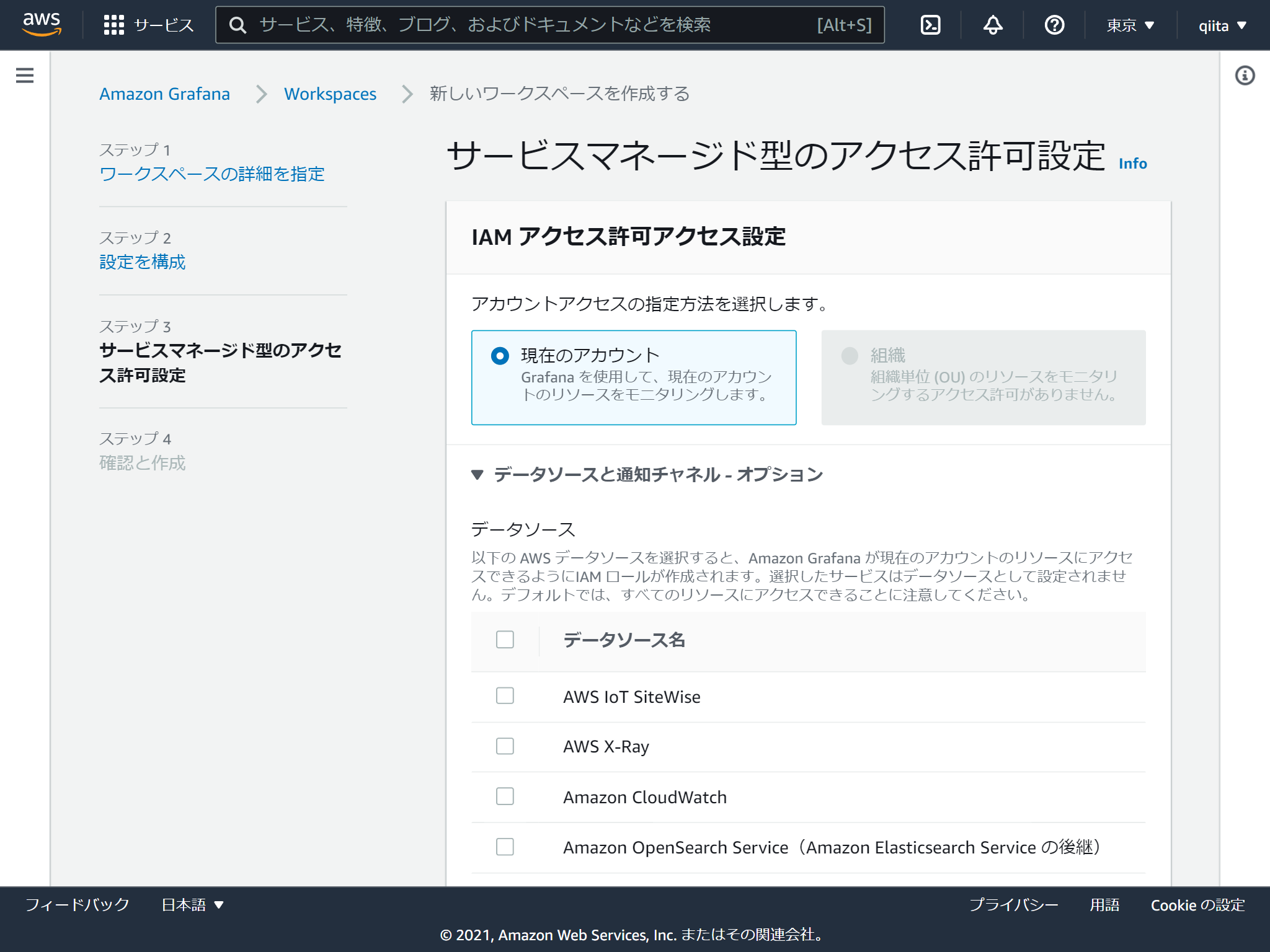
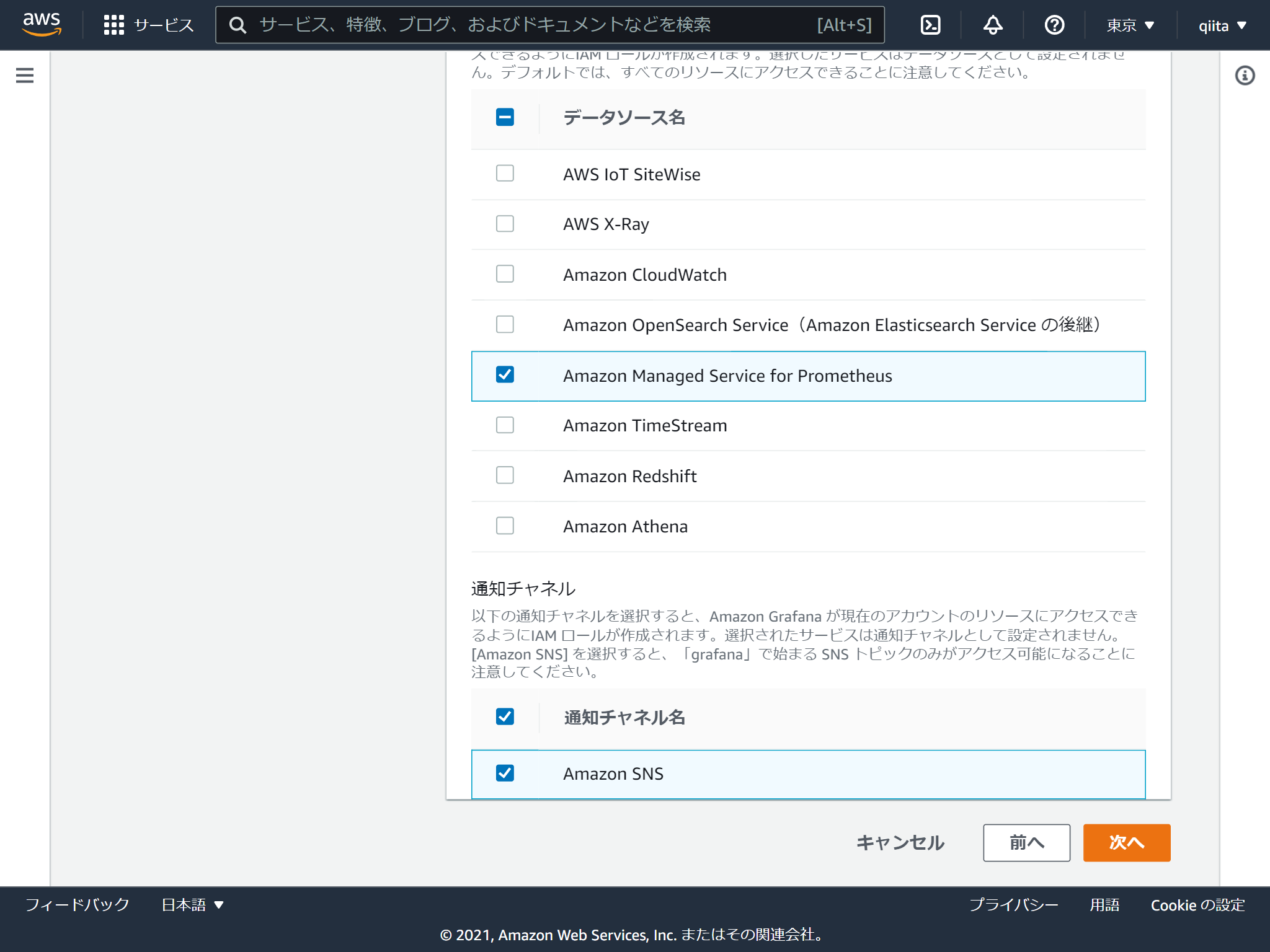
これで作成は完了です。 続いてログインするユーザーを追加します。「ユーザーとユーザーグループの設定」をクリック
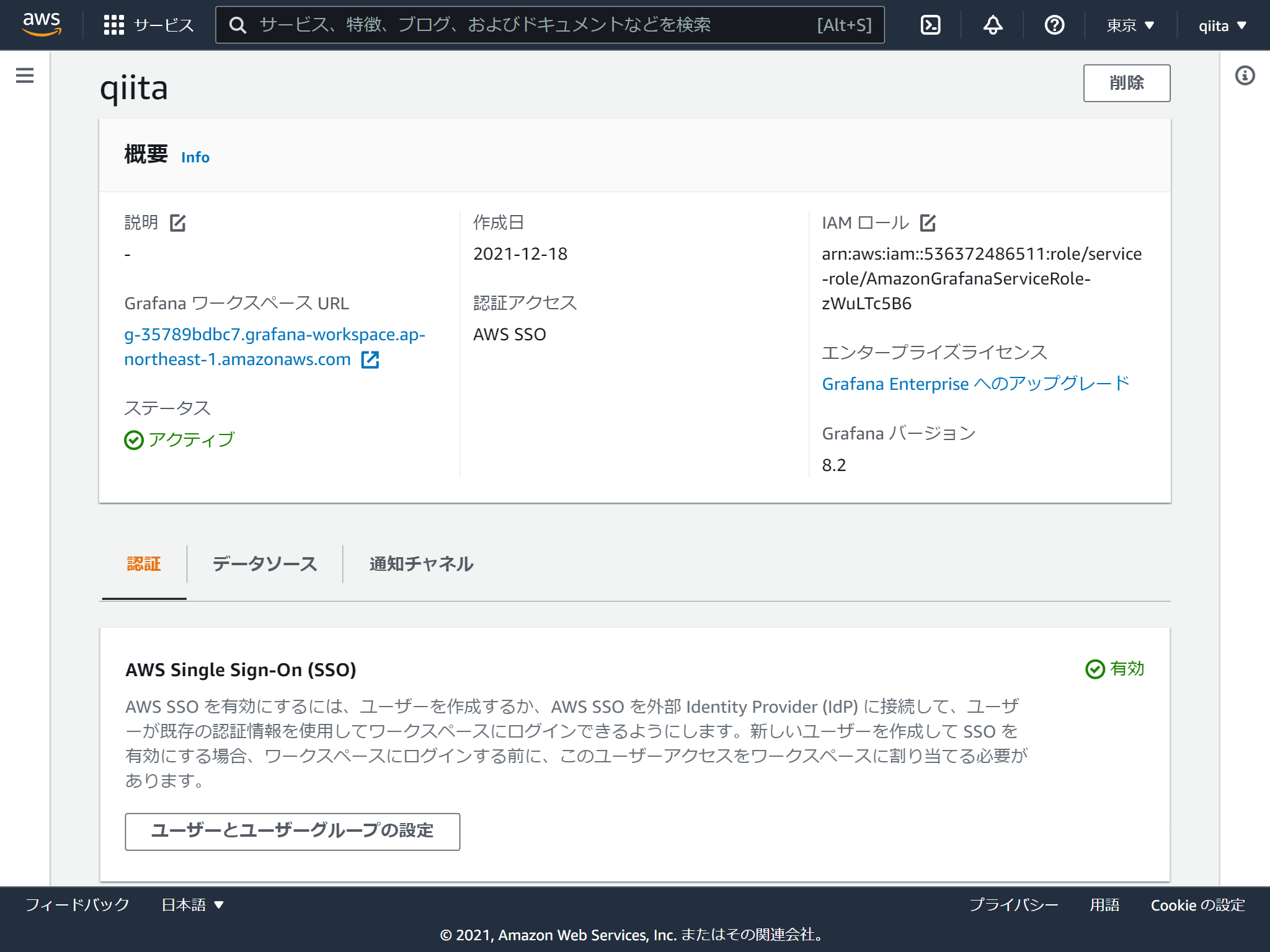
今回はAWS SSOで作成したグループを追加します。
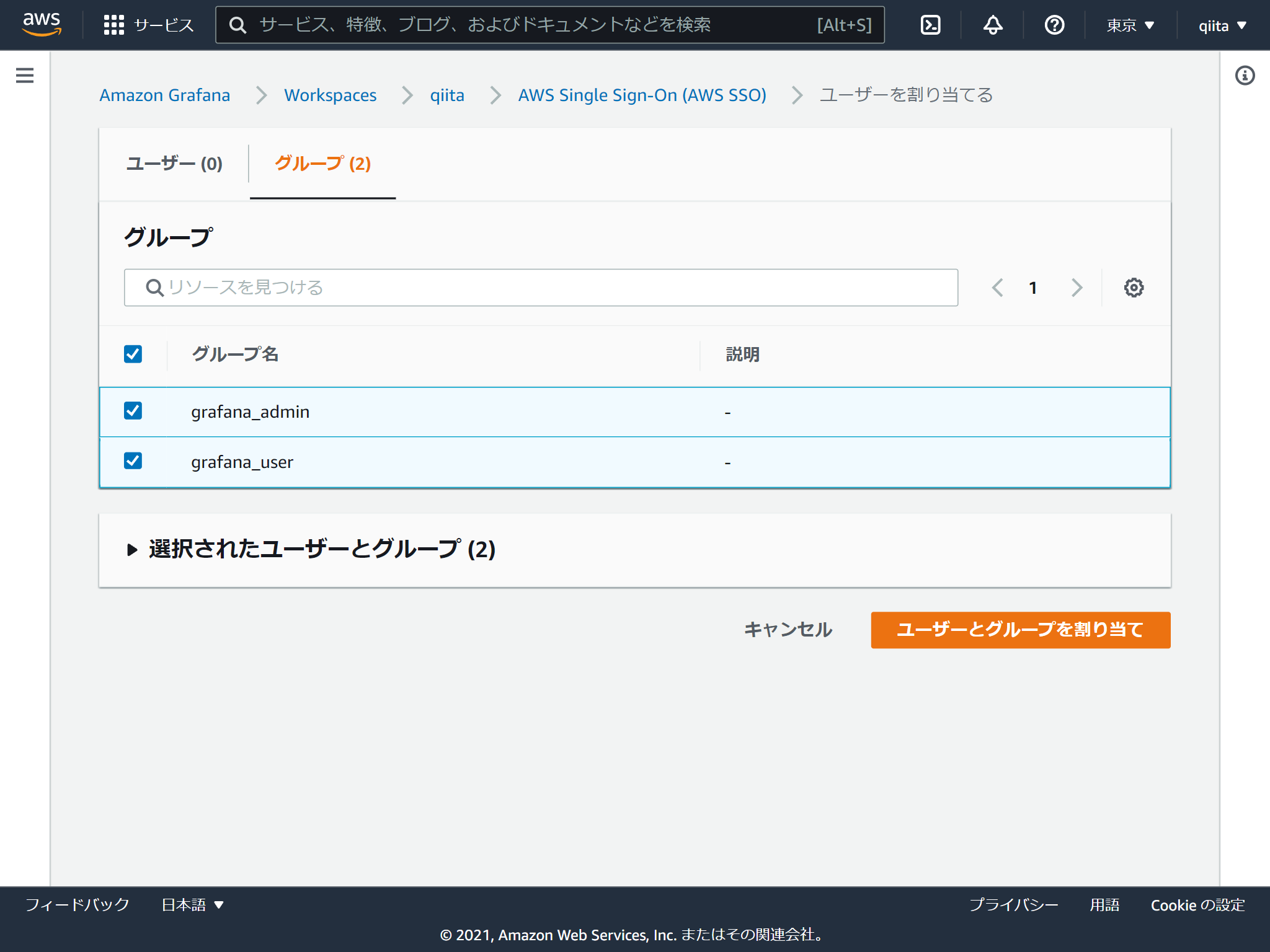
権限は閲覧者と管理者の2つあります。デフォルトが閲覧者で管理者に変更する場合はチェックを入れて「管理者を作成する」をクリックします。(閲覧者に戻す方法はないのかな?)
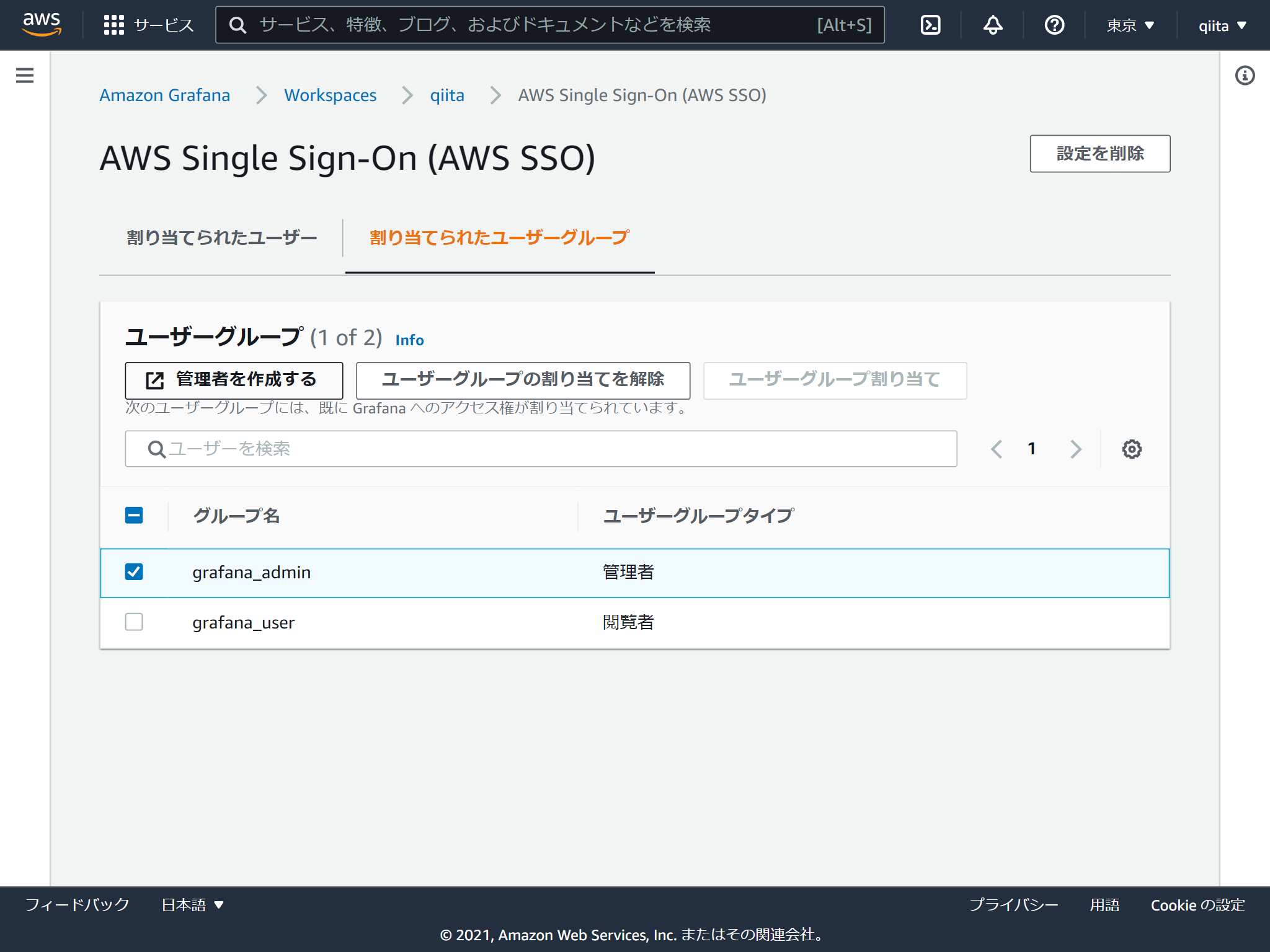
Grafanaログイン
マネジメントコンソールに表示されるワークスペースURLからアクセスします。設定したAWS SSOのユーザーでログインするとGrafanaの画面が表示されます。メニューにAWSのアイコンがありますね。
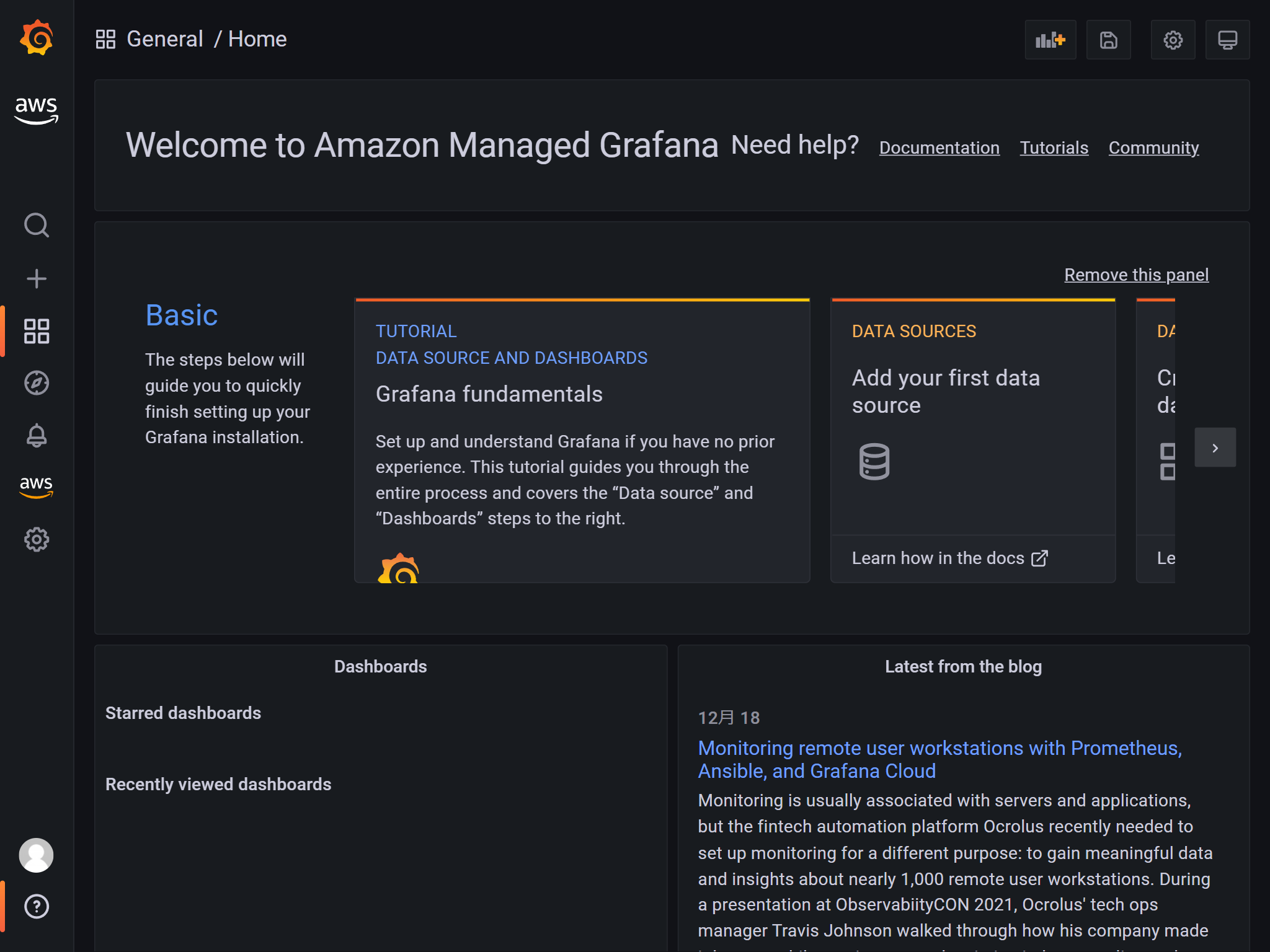
データソースにAmazon Managed Service for Prometheusを追加します。 AWSアイコンからデータソースをたどると追加できます。
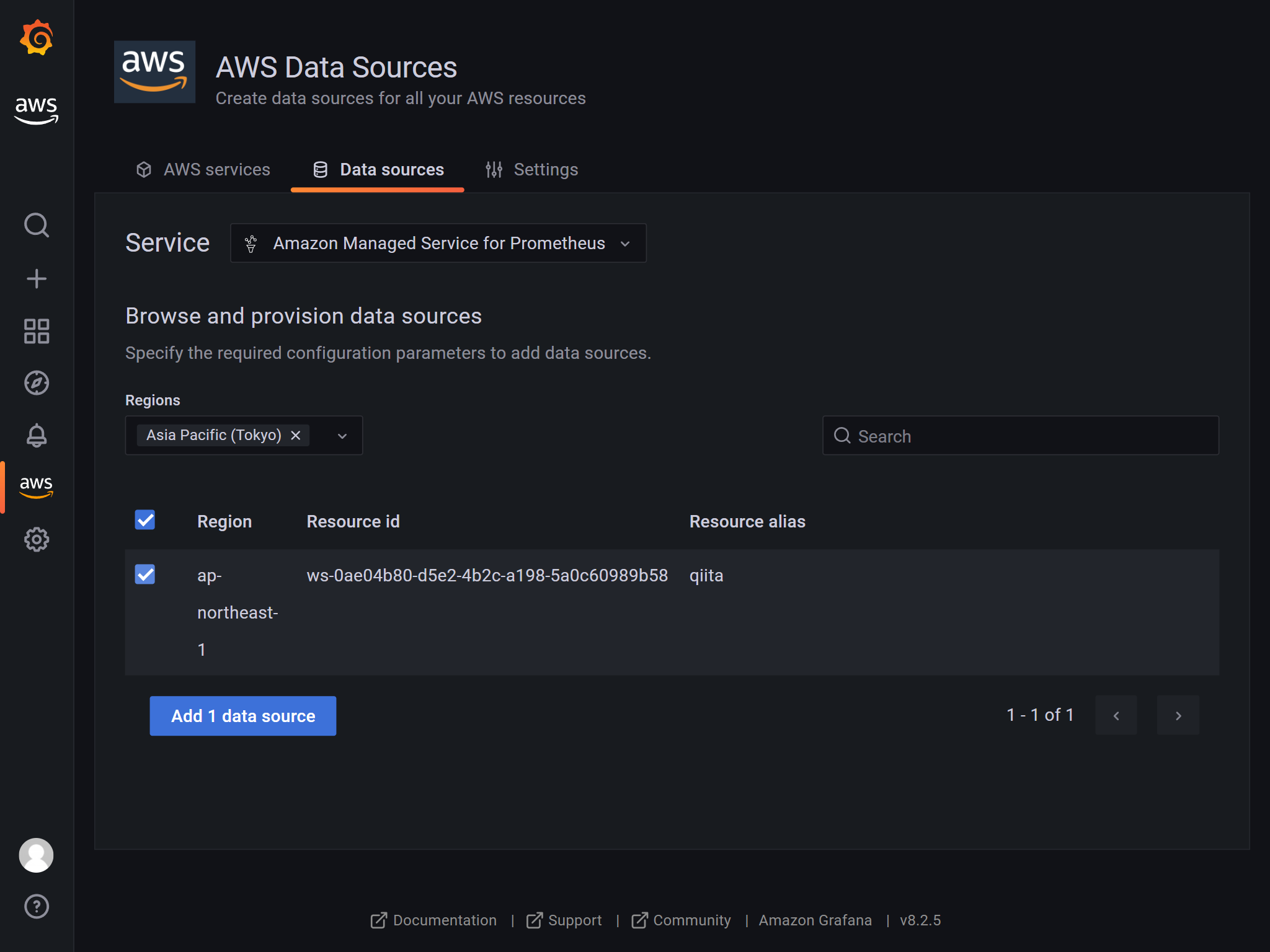
ここまでできれば通常のGrafana同様です。
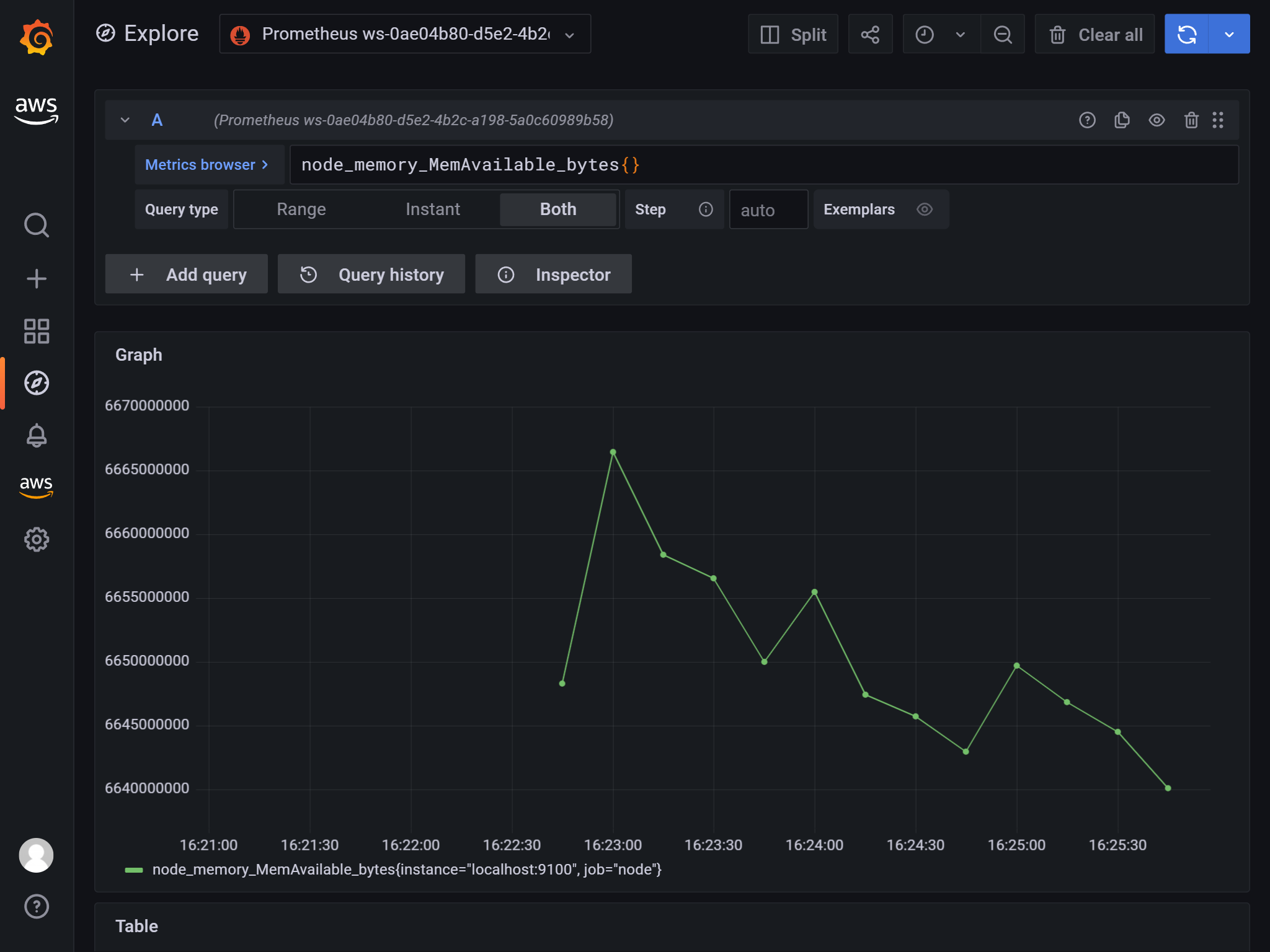
GrafanaのRepeat optionsで繰り返しチャート表示
過去にQiitaに投稿した内容のアーカイブです。
Raspberry PiにインストールしたPrometheusとNode exporterで取得したnode_cpu_scaling_frequency_hertzをGrafanaで可視化してみました。
設定無しでするとこんな感じ。
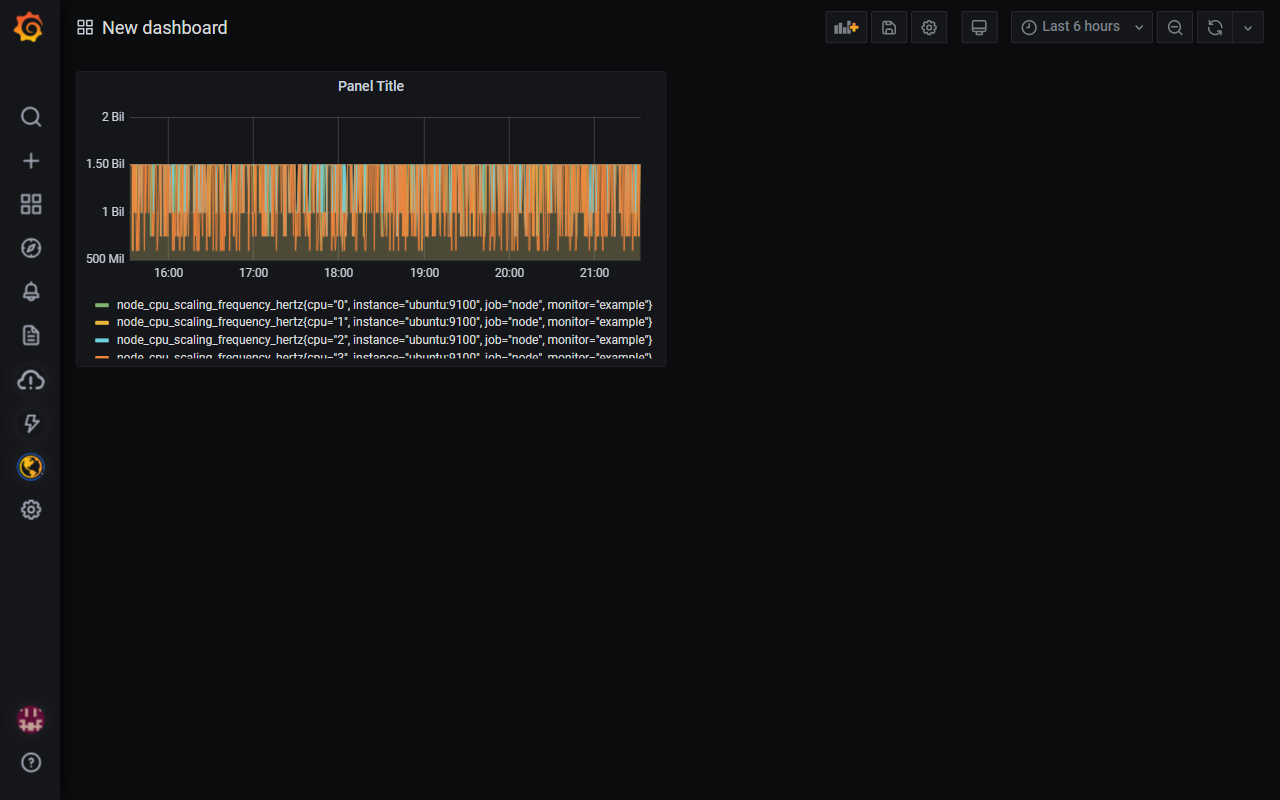
これを、CPUのコアごとのグラフにしてみたいと思います。
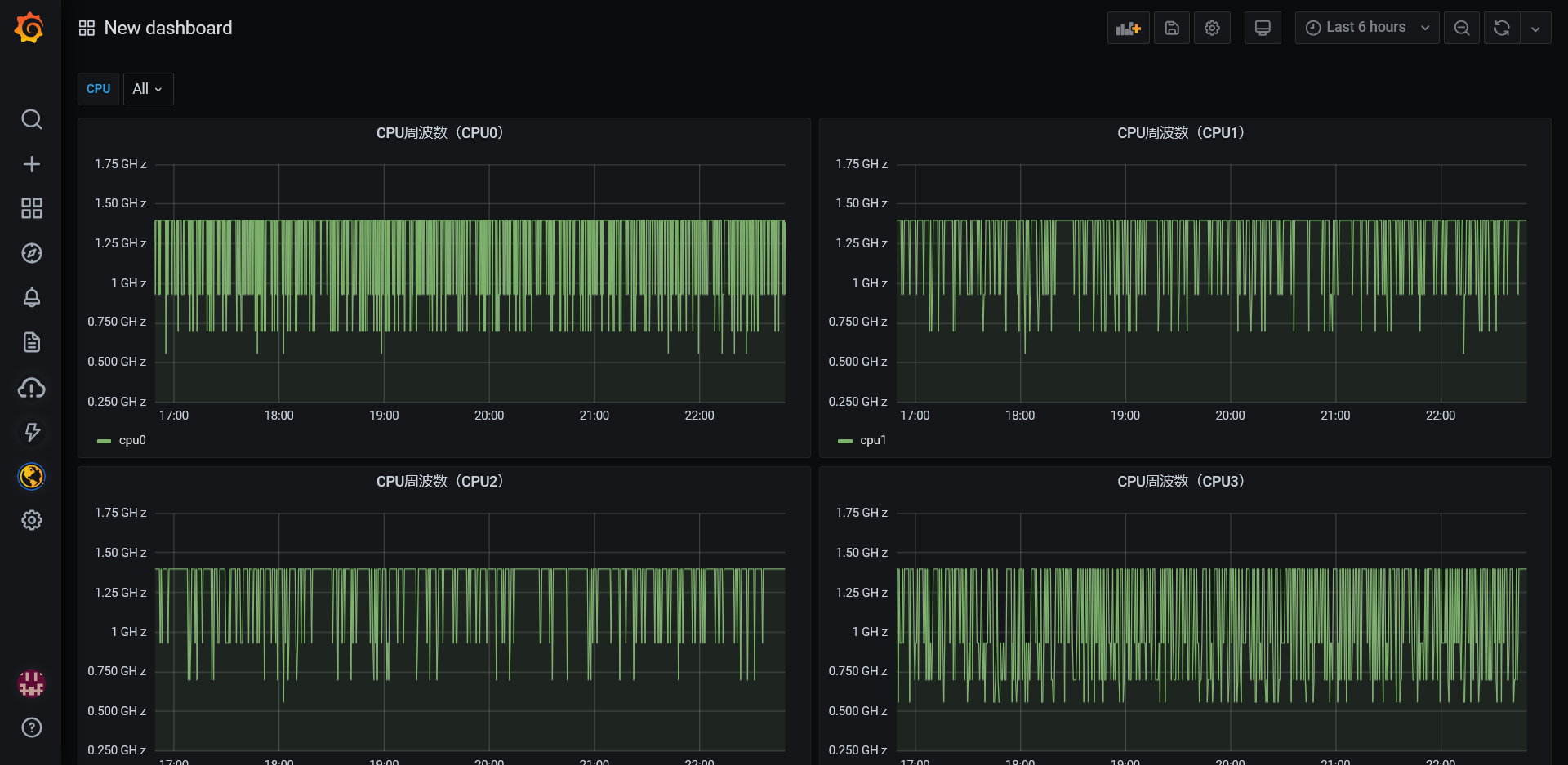
手順
Variableの追加
右上の設定ボタン(ギアアイコン)から、Variablesを追加します。
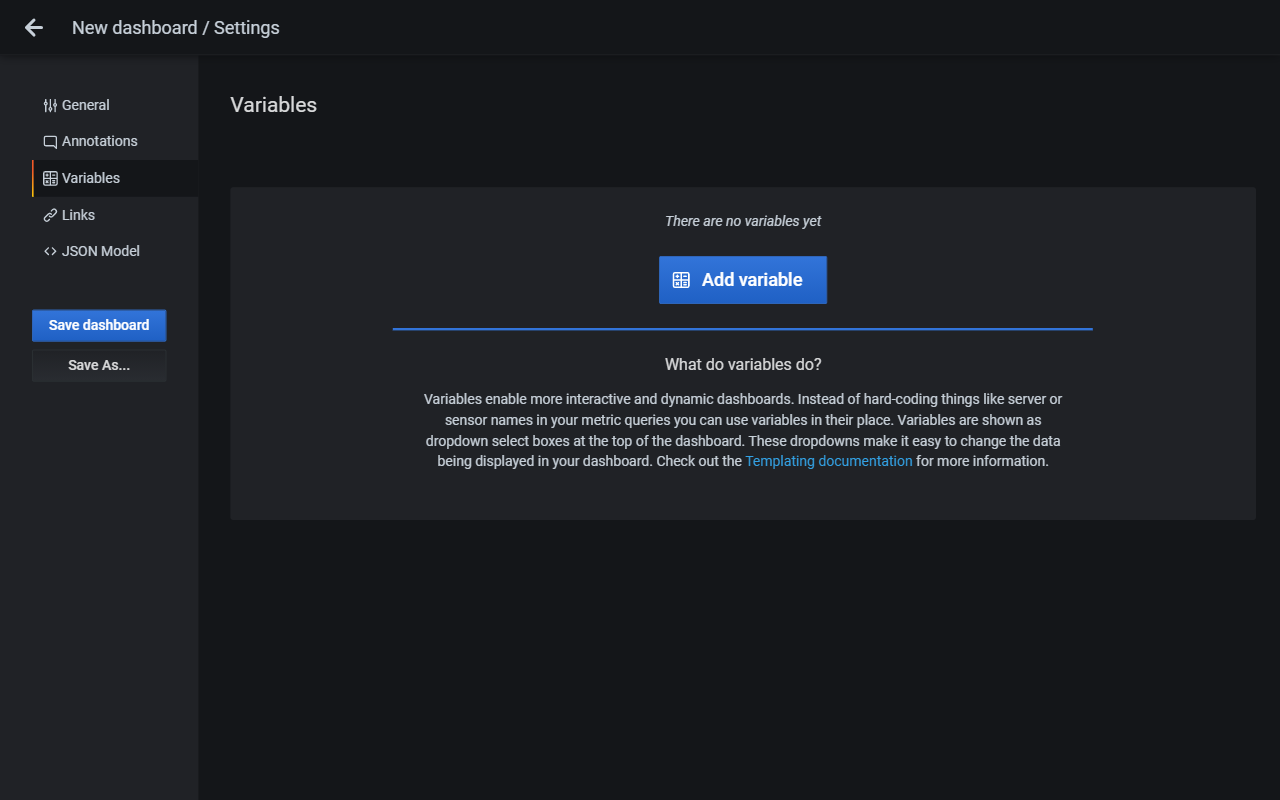
- General
| 項目 | 設定値 |
|---|---|
| Name | CPU |
| Type | Query |
- Query Options
| 項目 | 設定値 |
|---|---|
| Data Source | Prometeus |
| Refresh | On Dashboard Load |
| Query | label_values(node_cpu_scaling_frequency_hertz, cpu) |
| Sort | Alphabetical (asc) |
- Selection Options
| 項目 | 設定値 |
|---|---|
| Multi-value | 有効 |
| Include All option | 有効 |
Panelの設定
QueryのMetricsはこんな感じです。
| 項目 | 設定値 |
|---|---|
| Metrics | node_cpu_scaling_frequency_hertz{cpu="$CPU"} / 1024 / 1024 / 1024 |
| Legend | cpu{{cpu}} |
※/ 1024 / 1024 / 1024の部分は単位をGHzにしているだけですのであまり本題とは関係ありません。
右側のPanel設定の一番下にRepeat optionsがあります。ここにVariableで追加したものが選択できます。
(選択肢が出ないときは右上のApplyを一度押すといいかもしれません)
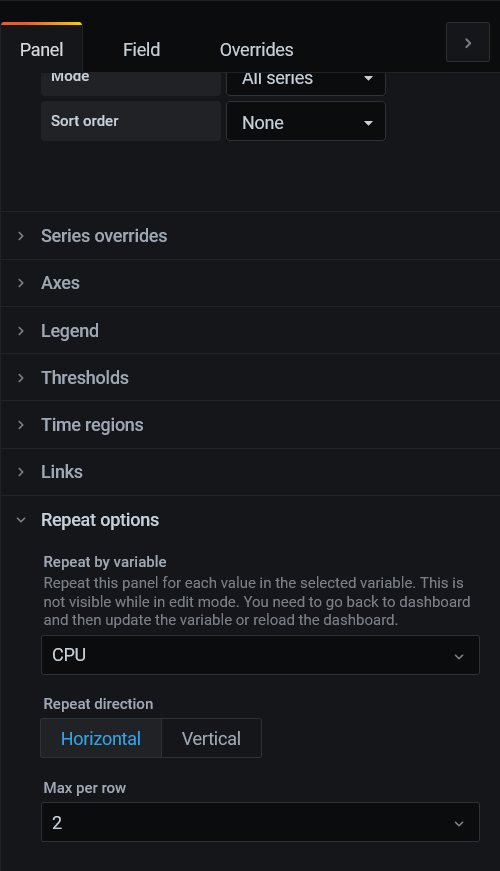
Variablesの設定をしたので、画面上部に選択肢が出てくるようになりました。
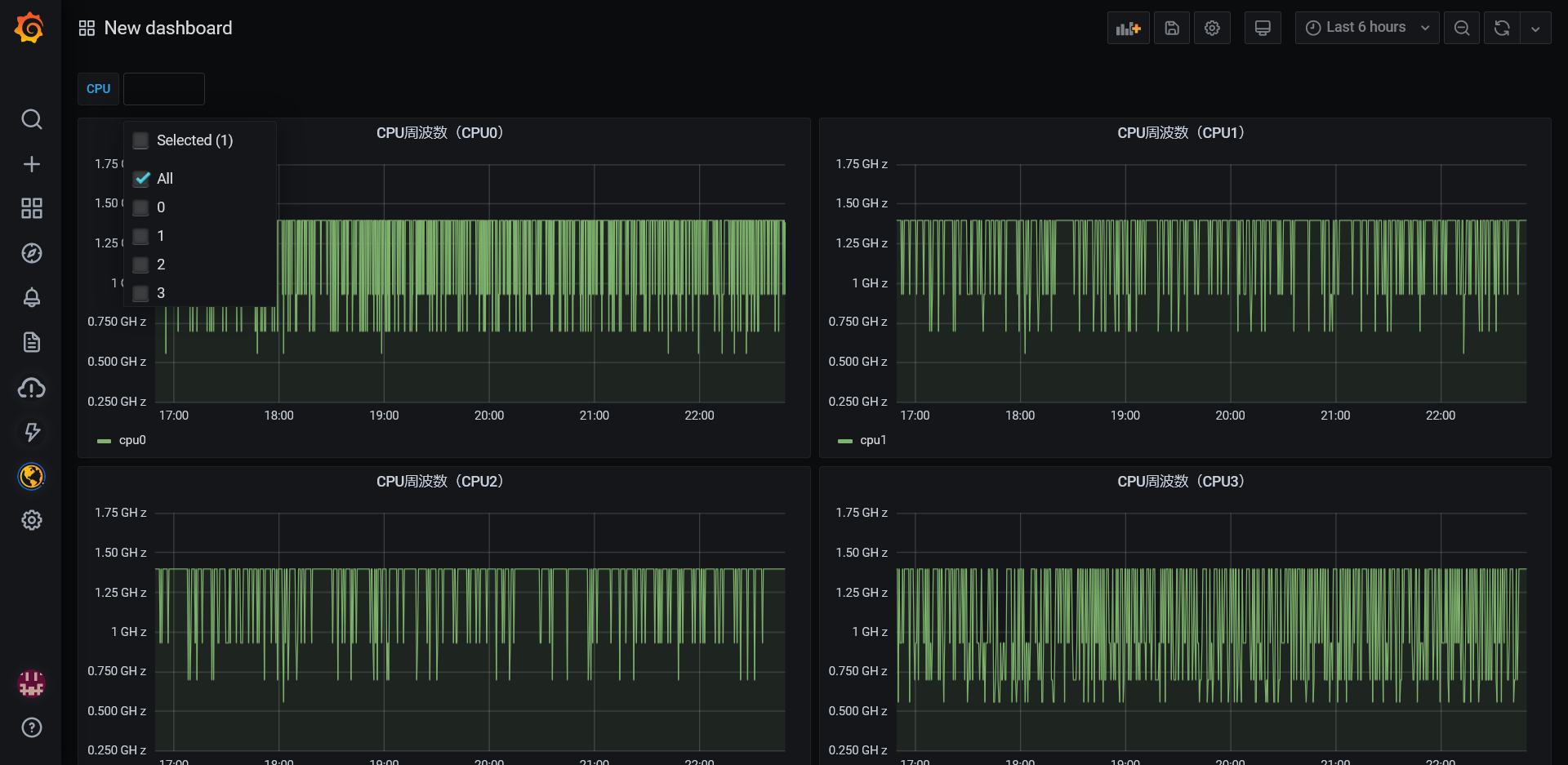
表示をGaugeにしたらこんな感じです。
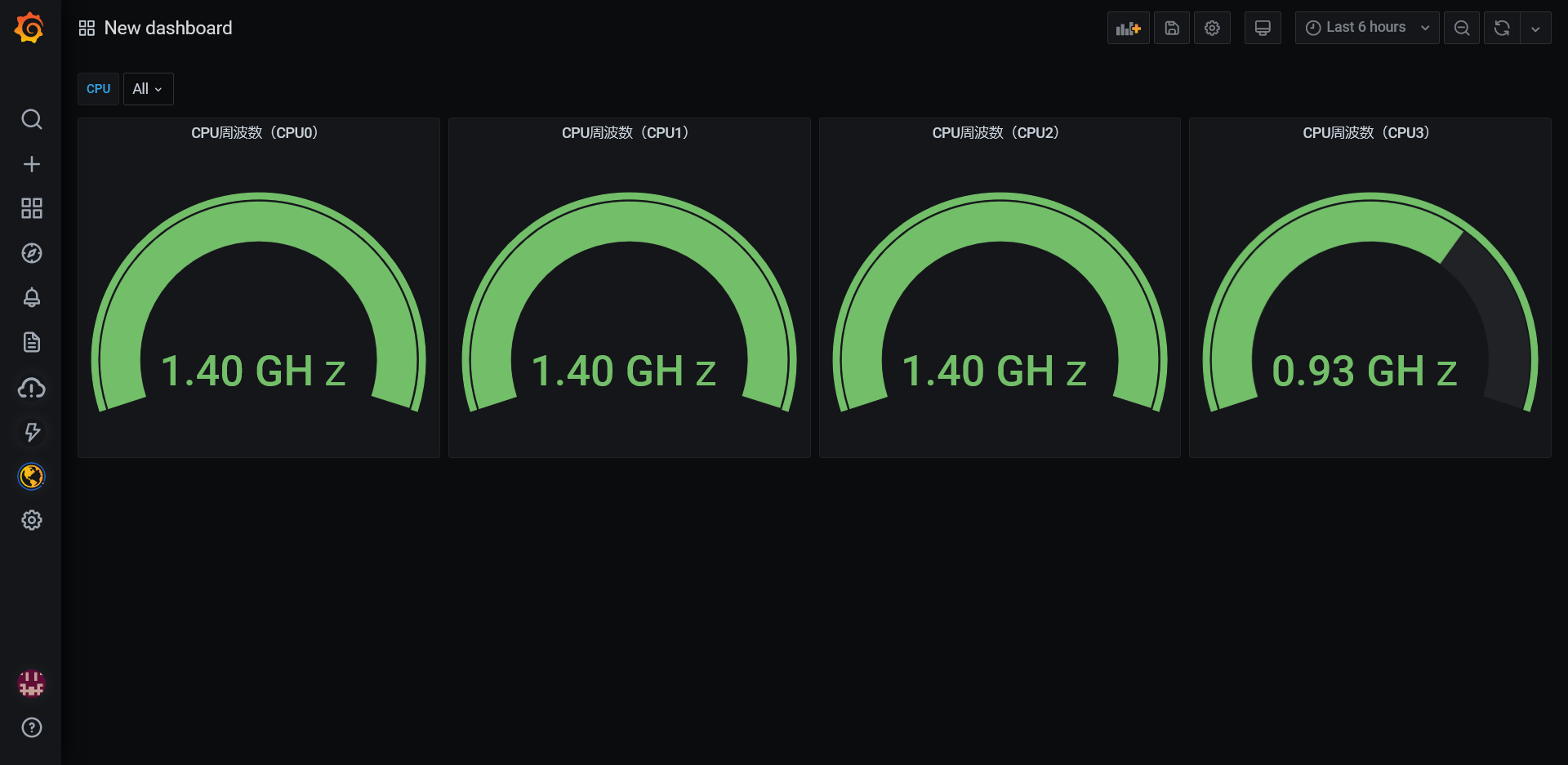
CPUコアごとの表示というのはあまり用途は無いですが、監視対象の全ホストのCPU利用率を一覧で見るなどは使いみちがあるかと思いました。
Raspberry PiのCPU温度をPrometheus+Grafanaで可視化する
過去にQiitaに投稿した内容のアーカイブです。
Raspberry Pi4が熱い。やけどしそうです。 CPU温度をGrafanaで可視化してみます。
- 2020/8/16時点のRaspberry Pi OSは
Debian Busterがベース - Busterのリポジトリに登録されている
prometheus-node-exporterのバージョンは0.17.0。 - Busterの次のバージョン
Bullseyeのリポジトリにはバージョン1.0.1があり、これを使うとCPU温度の値が取れる
PrometheusとGrafanaのインストールについては、以前書いた「PrometheusとGrafanaでRaspberry Piを監視」を参照ください。
バージョン1.0.1のprometheus-node-exporterをインストール
- https://www.debian.org/distrib/packages#search_packages でprometheus-node-exporterを検索
- 検索結果の
prometheus-node-exporter パッケージのbullseye (testing)をクリック - ページ下部にある
prometheus-node-exporter のダウンロードのarm64かarmhfを選択 ftp.jp.debian.orgで始まるリンクをクリックし、debパッケージをダウンロードsudo dpkg -i prometheus-node-exporter_[バージョン]_[アーキテクチャ].debでインストール
Grafanaで可視化
CPU温度はnode_thermal_zone_tempというメトリクスで取得されています。
私はCPUの周波数と合わせて、こんな感じで可視化してみました。
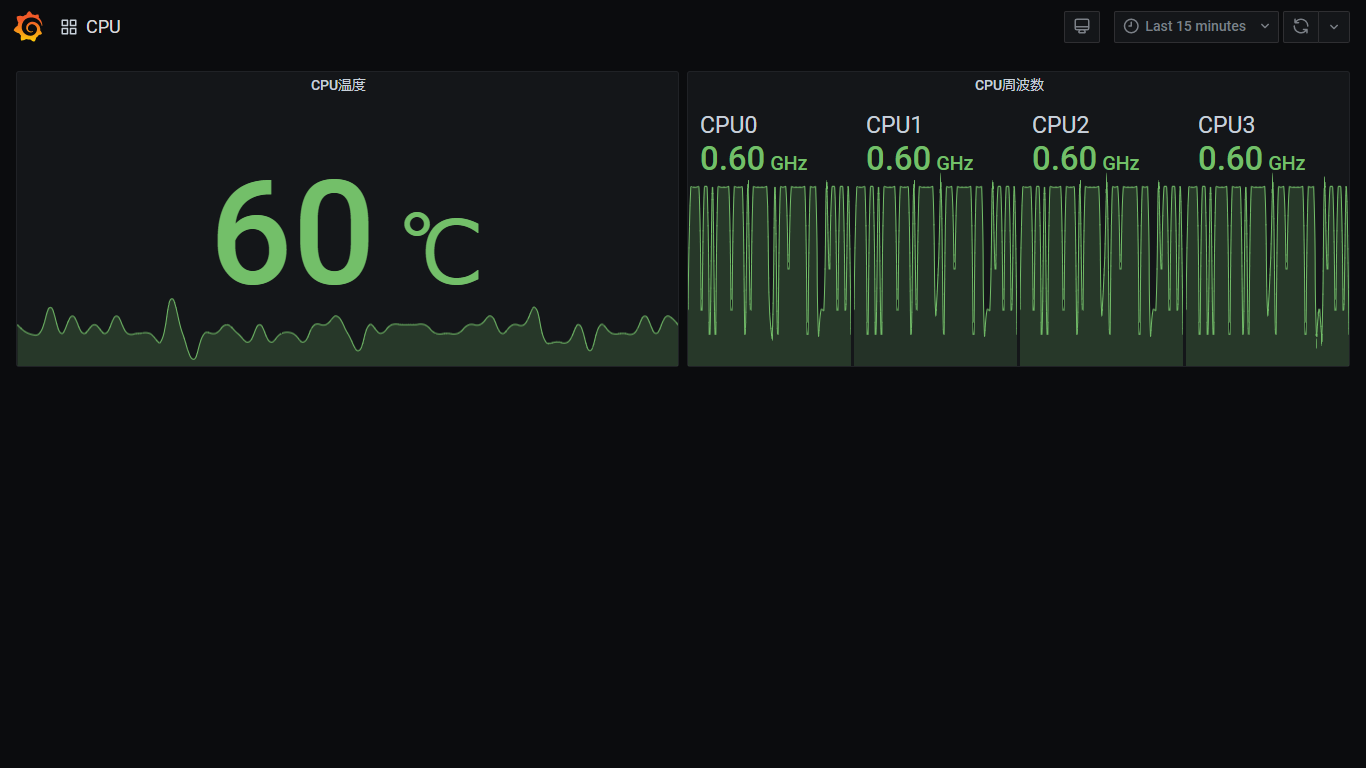
熱い